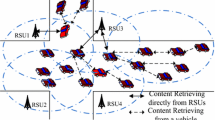Abstract
Providing an efficient and stable communication framework of Vehicular Ad hoc Network (VANET) is an emerging issue. Most of conventional VANET communication schemes only support short range transmission, vehicles need to relay traffic data or frequently switch to different roadside units. Such an ad hoc-based method suffers a high jitter delay and makes it difficult to develop travel and real-time multimedia services, such as traffic information dissemination and fleet management. Fortunately, existing novel wireless technologies, e.g. WiMAX mobile multi-relay (MMR), provide long transmission range and high transmission rate in mobile environments. This study presents a Safety/Vehicular Information Delivery (SVID) framework, an application-layer VANET communication protocol. A power-abundant, large size vehicle, called SIP-based relay vehicle (SRV), e.g. long distance transportation bus, plays as a relay station (RS) providing the connectivity to other small vehicles around it. To provide VANET services in SVID, this work adopts a SIP-based mechanism. The proposed scheme can provide more efficient communication than conventional VANET ad hoc mode. Simulation results show that the proposed scheme achieves a low SIP transaction time, jitter delay, frame loss rate while avoiding the broadcast storm problem.
Similar content being viewed by others
References
Wisitpongphan, N., Tonguz, O. K., Parikh, J. S., Mudalige, P., Bai, F., & Sadekar, V. (2007). Broadcast storm mitigation techniques in vehicular ad hoc networks. IEEE Wireless Communications Magazine, 14(6), 84–94.
Nekovee, M., & Bogason, B. B. (2007). Reliable and efficient information dissemination in intermittently connected vehicular ad hoc networks. In Proc. the IEEE 65th on vehicular technology conference (VTC2007-Spring), Apr. 22–25 (pp. 2486–2490).
Niyato, D., Wang, P., & Teo, J. C. M. (2009). Performance analysis of the vehicular delay tolerant network. In Proc. IEEE wireless communications and networking conference (WCNC 2009), Apr. 5–8 (pp. 1–5).
IEEE Standard for Local and metropolitan area networks Part 16: Air Interface for Broadband Wireless Access Systems Amendment 1: Multiple Relay Specification. IEEE Std., June 12 2009.
Rosenberg, J., Schulzrinne, H., & Camarillo, G. (2002) SIP: Session initiation protocol (RFC3261), June 2002.
Schulzrinne, H., & Wedlund, E. (2000). Application layer mobility using SIP. Proc. IEEE Service Portability and Virtual Customer Environments, 4(1), 29–36.
NCTUns 6.0 Network Simulator and Emulator. Available: http://nsl.csie.nctu.edu.tw/nctuns.html.
SIPp. Available: http://sipp.sourceforge.net/index.html.
SIP Express Router project. Available: http://www.iptel.org/ser.
Yang, K., Ou, S., Chen, H. H., & He, J. (2007). A multihop peer-communication protocol with fairness guarantee for IEEE 802.16-based vehicular networks. IEEE Transactions on Vehicular Technology, 56(6), 3358–3370.
Dikaiakos, M. D., Florides, A., Nadeem, T., & Iftode, L. (2007). Location-aware services over vehicular ad-hoc networks using car-to-car communication. IEEE Journal on Selected Areas in Communications, 25(8), 1590–1602.
Ni, S. Y., Tseng, Y. C., Chen, Y. S., & Sheu, J. P. (1999). The broadcast storm problem in a mobile ad hoc network. In Proc. the 5th annual ACM/IEEE international conference on mobile computing and networking (pp. 151–162).
Mussabbir, Q. B., Yao, W., Niu, Z., & Fu, X. (2007). Optimized FMIPv6 using IEEE 802.21 MIH services in vehicular networks. IEEE Transactions on Vehicular Technology, 56(6), 3397–3407.
Tseng, Y. C., Chen, J. J., & Cheng, Y. L. (2007). Design and implementation of a SIP-based mobile and vehicular wireless network with push mechanism. IEEE Transactions on Vehicular Technology, 56(6), 3408–3420.
Huang, C. M., Lee, C. H., & Zheng, J. R. (2006). A Novel SIP-based route optimization for network mobility. IEEE Journal on Selected Areas in Communications, 24(9), 1682–1691.
Jia, W., Wang, T., Wang, G., & Guo, M. (2007). Hole avoiding in advance routing in wireless sensor networks. In Proc. IEEE wireless communications and networking conference (WCNC 2007), Mar. 11–15 (pp. 3519–3523).
Author information
Authors and Affiliations
Corresponding author
Rights and permissions
About this article
Cite this article
Chiu, KL., Hwang, RH. Communication framework for vehicle ad hoc network on freeways. Telecommun Syst 50, 243–256 (2012). https://doi.org/10.1007/s11235-010-9401-4
Published:
Issue Date:
DOI: https://doi.org/10.1007/s11235-010-9401-4




